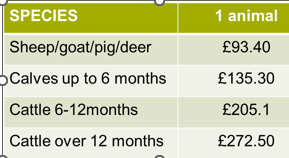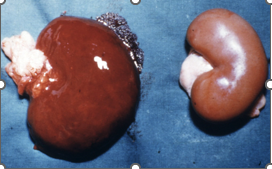L29: Sudden death in ruminants
1/27
There's no tags or description
Looks like no tags are added yet.
Name | Mastery | Learn | Test | Matching | Spaced |
|---|
No study sessions yet.
28 Terms
How do you take a history of sudden death
Number/groups/fields/ages affected
Progression of signs (if any)
Vaccination & worming history
Management
Recent treatments?
Changed fields or feed?
Unusual weather events?
How do you an environment examination
Observational skills v v important
Suspected toxicity- environment examination
What animals do you do an individual clinical exam
Individuals clearly sick or affected
How much are PMEs for different animals
On spot diagnosis
Collect samples for further analysis

When do you do further diagnostic tests
As appropriate
Routine part of PM exam within reason
how do you do analyse the data and decision make for sudden death
Lots of animals at risk
Quick and decisive
Management changes?
E.g. feeding/field
Control programme?
E.g. vaccination, worming
Treatment of individuals?
discuss actions before leaving farm
Report lab results and follow up
What are some causes of sudden death in grazing animals
Infectious
Septicaemia/toxaemia
Pneumonia
Anaemia
Liver fluke
Haemonchus
Toxicity – plant or chemical
Inadvertant
Iatrogenic
Nutritional
Metabolic disease
Bloat
CCN
White muscle …
Other e.g. climate, trauma
Describe when infectious causes of septicaemia or toxaemia are seen
Common, usually bacterial
Often in environment, or commensals
Predisposed by management factors
Good nutrition e.g. clostridial diseases
High stocking density e.g. salmonellosis, pneumonia
Flooding e.g. leptospirosis
How do you diagnose infectious septicaemia or toxaemia
History esp vaccination status, management
Clinical signs noted
Changes in mucous membranes colour
PME

What does this show
Clostridial entertoxaemia
•Three unvaccinated yearling dairy-bred bullocks at grass had died in a week. PME confirmed a diagnosis of clostridial enterotoxaemia.
What is the adult ewe clostridial vaccination protocol
Priming injection then 4-6 weeks later a 2nd injection.
Booster 4-6 weeks prior to lambing.
Maximises colostral antibody levels.
What is the young lambs clostridial vaccination protocol
Maternal antibodies last up to 12 weeks (Clostridial)
(3 weeks – Mannheimia (P component of some vaccines)
What is the weaned lambs clostridial vaccination protocol
From 8 weeks in age
if short time to slaughter is vaccination sensible?
given an overview of infectious anaemia
E.g. acute fascioliasis, haemonchosis
Should be obvious premonitory clinical signs BUT infrequent or cursory inspection…
Diagnosis
History esp. parasite control, clinical signs
Pale mucous membranes
PME more useful than FEC or blood testing
Prevention – parasitology lectures
Give an example of infectious anaemia in cattle
Two calves, aged 8 weeks and 14 weeks, were found dead. PME confirmed acute fascioliasis. The calves had been moved to a field recently cut for silage so they were grazing the longer grass at the edge of marshy areas. These areas are ideal snail habitat and it is likely that large numbers of metacercariae were present.
How do you diagnose plant toxicity
History esp. access to toxic plants, all deaths in same field etc
Search of field
PME – presence of leaves in rumen. Variety of PME signs
Give an example of plant toxicity in a dairy cow
A dairy heifer was found dead 6 hours after being observed to be alive and well. PM revealed haemorrhages on the heart but little else. Six hours later a further heifer was found dead. Inspection of the field revealed an old house site and a partially grazed oleander tree.
What are some causes of plant toxicity
Plant e.g. yew, oleander
Access to old house site
Prunings put into field
Storm bringing down boughs
Describe toxicity of minerals and how it is diagnosed
Mineral e.g. selenium, copper
Iatrogenic: Accidental over-supplementation
Animals fed wrong type of feed
Deaths usually very rapid (esp. Se)
Diagnosis
History of supplementation or feed change
Se: blood Se levels
Cu: Cu levels, PME
What are some other causes of toxicity
lead, cyanide etc
Access to random stuff
Calves in old buildings (lead paint)
Accidental access to pest poisons
Medicated feed given to wrong animals
give an example of other (lead, cyanide) toxicity
In a group of 90 calves, 2 were found dead and another 2 were sick with neurological symptoms. Blood lead levels were in the toxic range. The calves had access to a rubbish pile 2 days previously.
What are some metabolic disturbances that can cause sudden death
Hypocalcaemia
Ketosis
Hypomagnesaemia
obvious in frequently observed animals
Give an example for metabolic disturbances
Hypomagnesaemia was diagnosed as the cause of sudden death of 3 cows in a group of outwintered autumn-calving beef cows in the Borders. The outbreak was notable for the fact that no sign of clinical disease was detected.
How can a nutritional imbalance cause sudden death
Change in GIT function e.g.
Acidosis
Bloat
Gut torsion
Deficiency of essential nutrients e.g.
Intrinsic due to change in microflora (CCN)
Extrinsic (water deprivation)
What can water deprivation lead to
to Salt toxicity
Abdominal pain and regurgitation
Nervous signs
Ataxia, circling, blindness, seizures, aggression
Give an example of nutritional changes of GIT function
In a herd of 150 cows, 3 died and a further 7 were ill. PME confirmed a diagnosis of acidosis. Enquiry revealed the cows diet was being supplemented with liquid waste from a nearby ice-cream factory. The day before the farm’s water supply had broken down and it is likely the cows overindulged on the liquid ice-cream.
Give an example of nutritional deficiency of an essential nutrient
Four recently weaned calves from a mob of 15 died over a period of 3 days. They had recently had a change in feed. Histopathology of the brain from 1 calf confirmed cerebro-cortical necrosis consistent with thiamine deficiency (Vit B1)
How do you diagnose sudden death
Prevent further cases asap
Infectious: change husbandry, antibiotics, vaccination, anthelmintic as appropriate
Toxicity: remove from source, therapy as appropriate
Metabolic: treat as appropriate, changes to husbandry for remainder of animals
Nutritional: change diet, therapy as appropriate